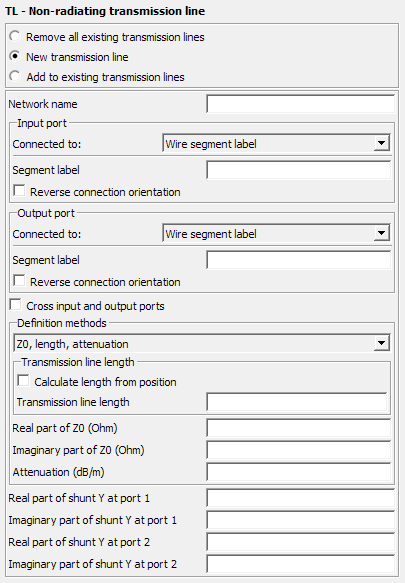TL Card
This card connects a non-radiating transmission line between Feko geometry or other general non-radiating networks or transmission lines.
On the Source/Load tab, in the Loads /
networks group, click the ![]() Transmission line (TL) icon.
Transmission line (TL) icon.

Figure 1. The Non-radiating transmission line dialog.
Parameters:
- Remove all existing transmission lines
- If checked, all previously defined transmission lines are deleted. All the other input parameters are ignored.
- New transmission line
- Defines a new transmission line, all previously defined transmission lines are replaced.
- Add to existing transmission lines
- An additional transmission line is defined.
- Network name
- The name of the transmission line.
- Input port
- The input port (start of the transmission line) can be connected to geometry or other non-radiating ports in a number of ways.
- Output port
- Same as for Input port, but applies to the end of the transmission line.
- Cross input and output ports
- The positive port voltage is in the direction of the segment that it is connected to (from the start to the end point of the segment). Thus the input and output ports of the transmission line have unique orientations. If this item is checked the transmission line connecting the ports is crossed.
- Calculate length from position
- If checked, Feko determines the length based on the geometrical distance between the start and end points. Note that this feature is only available when both transmission line ports are connected to segments or vertices/nodes (the ports do not have to be the same type).
- Transmission line length
- The length of the transmission line in metres. This value is scaled with the scaling factor of the SF card.
- Attenuation (dB/m)
- Losses of the transmission line in dB/m. Note that since the propagation constant is taken as the propagation constant of the medium in which the start and end ports are located, the attenuation specified by this parameter is added to any losses of this medium. This factor is not affected by scaling specified with the SF card. This means that should a scaling factor which reduces the length of the transmission line be added, the total loss through the line will be less. (The length is now less and the loss per distance remained the same.)
- Velocity of propagation (%)
- The propagation speed through the transmission line relative to the speed of light.
- Material label (dielectric)
- The label of the dielectric medium (as defined in the DI card) used as the background medium for the transmission line.
- Real part of Z0 (Ohm)
- Real part of the characteristic impedance of the transmission line in Ohm
- Imaginary part of Z0 (Ohm)
- Imaginary part of the characteristic impedance of the transmission line in Ohm. Note that the characteristic impedance only defines the ratio between the voltage and current of the two waves propagating along the line. It does not specify any losses.
- Real part of shunt Y at port 1
- Real part of the shunt admittance at the input port in Siemens. (This admittance is across the port, connecting the two wires of the transmission line.)
- Imaginary part of shunt Y at port 1
- Imaginary part of the shunt admittance at the input port in Siemens.
- Real part of shunt Y at port 2
- Real part of the shunt admittance at the output port in Siemens. (This admittance is across the port, connecting the two wires of the transmission line.)
- Imaginary part of shunt Y at port 2
- Imaginary part of the shunt admittance at the output port in Siemens.
To illustrate, a transmission line port connected to a wire segment is discussed, but this applies to connections at edges as well as nodes.

Figure 2. General placement of loads and excitations.

Figure 3. Load placement for S-parameter calculations.
Note that the propagation constant and thus also the propagation loss of the transmission line is the same as that of the medium surrounding the port unless an additional loss tangent is specified in the Losses field. If this is free space the transmission line will be lossless. For transmission lines with a propagation constant that is higher than that of the surrounding medium, such as coaxial cables filled with dielectric material, the length of the transmission line should be reduced.
- When both ports of a transmission line are internal (not connected to geometry), the propagation constant of the background medium is used for the transmission line.
- If one port of the transmission line is internal, the propagation constant of the medium at the other port (connected to geometry) is used.
- Should both ports be connected to geometry, the medium of the input port (Port 1) is used for the propagation constant of the transmission line.
- Additionally, if a transmission line is located inside a planar multilayer substrate,
the following applies:
- If the transmission line is connected to geometry:
- and lies inside a layer, the propagation constant of the medium of that layer is used.
- and lies on the interface between two layers, the average medium between the two layers is used for the propagation constant.
- If the transmission line is not connected to geometry then either the upper or lower medium is used depending on which one is lossless, or should both be lossless, the one with the greatest propagation constant, , is used
- If the transmission line is connected to geometry:
Losses in the transmission line network (due to the shunt admittances or transmission line losses directly) are taken into account and will for instance reduce antenna efficiency or gain.